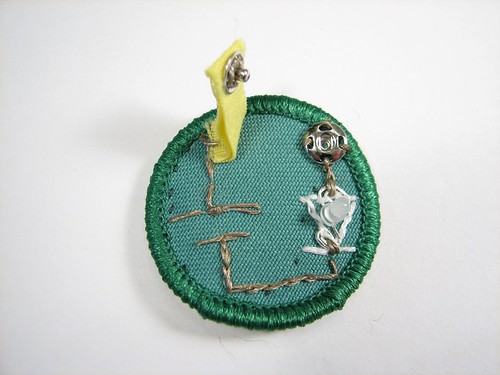
The proliferation of spoof, nerd, science, and electronics merit badges has demonstrated that geeks like to show off their skills and accomplishments. One skill is particularly appropriate for the format: soft circuitry. By building your own soft circuit onto an actual badge you can demonstrate your mastery.
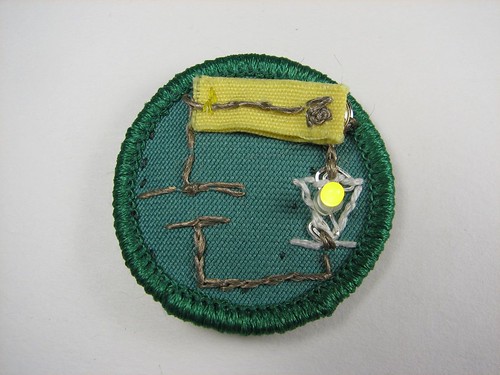
The size of the badge is just right for a simple circuit with a battery, a switch and an LED. The crowning touch is that the stitched circuitry can form the circuit diagram as well.
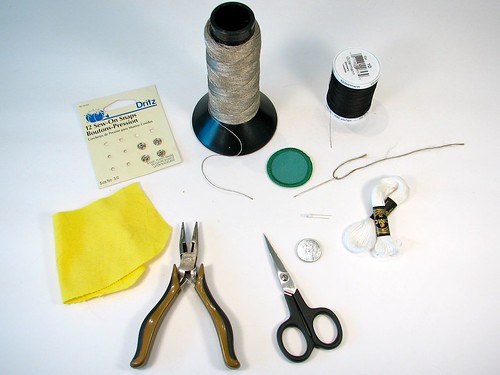
You’ll need conductive thread, non-conductive thread, fabric scraps, snaps, scissors, pliers, an LED, a 3 V coin cell battery such as CR2032, and, of course, a blank merit badge. That last can be difficult as the boy scouts are pretty restrictive on the use of their badges. The girl scouts are more helpful, and even have a couple of different blank badges available in an appropriate size that they’ll sell to the public. You can alternately make your own circle of fabric with stitched edges. Making your own will prevent having to sew through the iron-on glue that is on most readily available badges.
There are lots of online resources for soft circuitry. Leah Buechley wrote an excellent introduction to DIY electronic sewing and has a good materials page. Fashioning Technology links to several soft circuit tutorials. Diana Eng’s Fashion Geek book is a good starting point for all kinds of fun.
Sternlab’s LED Sewing kit would be ideal for this project. You can also get conductive thread from SparkFun. You can get little yellow LEDs over in the Evil Mad Science Shop, too.
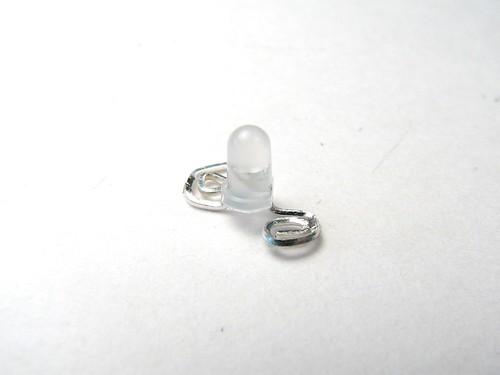
The first step is to bend the leads of the LED to a shape that can be sewn. Spirals are nice and compact.
Yellow or red LEDs are a good choice for this project as they require a lower voltage than shorter wavelength LEDs like green and blue. Conductive thread is somewhat resistive, so your resulting voltage may not be high enough for some colors of LED.

Sew the LED in place by embroidering around it with regular embroidery thread with the symbol for a diode, which is a triangle pointing at a line. The cathode should go toward the line, and the anode toward the triangle end of the symbol. For most through-hole LEDs, the cathode side is flatted and has a shorter lead.

With conductive thread, sew the cathode lead down firmly with a couple of stitches, and continue the circuit around to the negative side of the battery. The battery symbol is two parallel line segments, one longer than the other, with the shorter one representing the negative side of the battery.
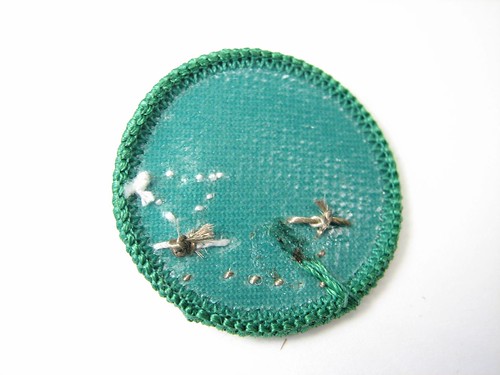
Tie off in the middle of the battery symbol with a decent sized knot on the back of the badge so that it will make good contact with the battery.

The next step is to start the battery holder on the back of the badge. Make a nice sized knot and a couple of stitches in a scrap of fabric a little larger than the battery (a little bigger than an inch across). These will connect to the positive side of the battery. Then make a long stitch to the edge of the fabric and through the to the front of the badge. This will keep the thread insulated from accidental contact with the rest of the battery.

Your thread should come through where you want to start the positive end of the battery symbol.

In order to keep from short circuiting your battery, you’ll need to keep the conductive thread on the top side of the badge until you are clear of the battery location. As you continue the circuit toward the switch, only pick up a few threads on the top of the badge fabric. You can even tie your thread onto itself rather than make a stitch to form the right-angle turn away from the battery symbol.
The next step is to sew on the fabric for the switch. Use a narrow strip fabric or a ribbon folded in half, and tack it down on one end with non-conductive thread.

Continue sewing the conductive thread on the top surface of the switch to keep it insulated from the rest of the circuit. Sew one half of the snap onto the end of the switch firmly with the conductive thread and tie off the end.

To get a snug fit on the battery holder, sew the fabric down around the edge of the battery, making sure to keep the one conductive thread going to the front of the badge insulated from the rest of the battery. After sewing, trim the corners so they don’t show when you turn the badge around.
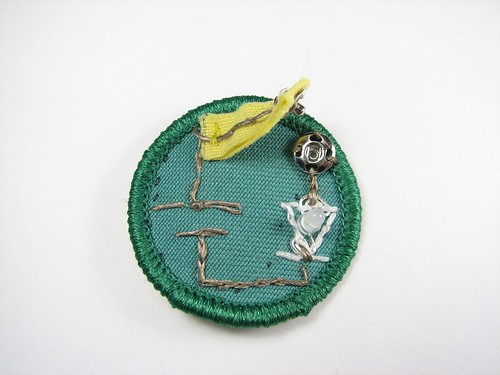
The last step is to connect the other side of the snap to the anode of the LED. Sew the snap down firmly with the conductive thread and then stitch over to the LED. Wrap the thread around the anode lead firmly a couple of times and tie it off.

Connect your switch and admire your soft circuit prowess!
If your circuit doesn’t light immediately, try squeezing your battery holder to make sure it is getting good contact. If that doesn’t work, try flipping your battery over in case it was reversed. You can also check the continuity of your circuit with a mulitimeter.
Conductive thread is notorious for fraying and unravelling, so once you’ve made sure that your circuit works, you may want to use some fabric glue to keep the knots from coming undone.
You can add some hook side velcro to the back of your badge to use it with a laptop sash or sew it directly onto a prominent display location. Just be sure to leave access to change the battery!




This is so cool!!!!!!
This is marvellous. Having just completed my first test-case soft circuit which wasn’t far off this exact same setup (complete with battery pocket) I’ll be eagerly searching around for merit-badge style blanks in the UK – to the haberdashery!
This. is. MAGNIFICENT.
We saw this page on our store referers.
Man, I can’t say enough good things about this. Because, of course, MAKING the badge is its own accomplishment. Oh, that’s just fantastic.
Our sincere compliments on your magnificent awesomeness!
— The nerd merit badges dot com team
I cant find conductive thread. Suggestions???
Sparkfun!
—
Windell H. Oskay
drwho(at)evilmadscientist.com
http://www.evilmadscientist.com/